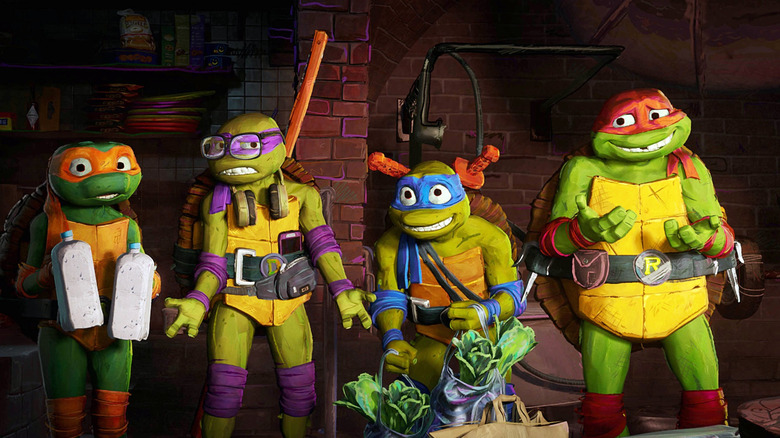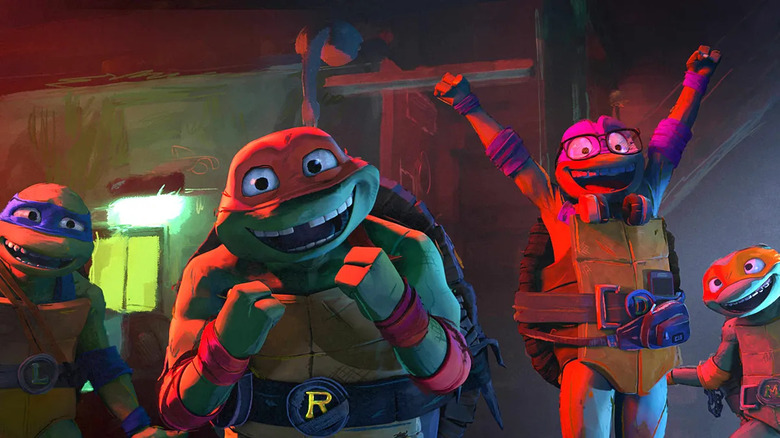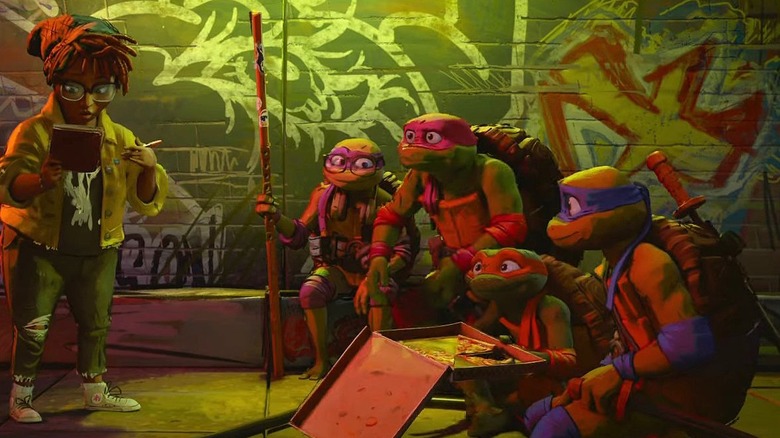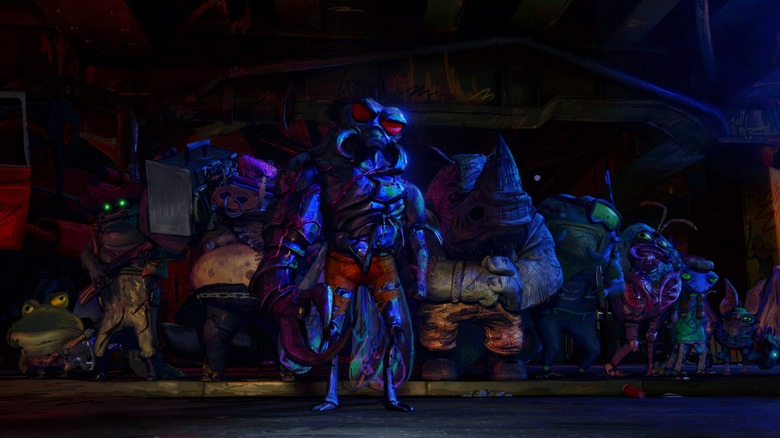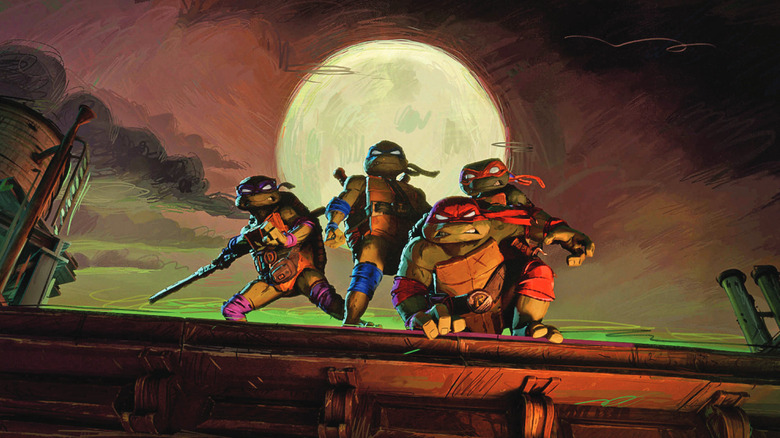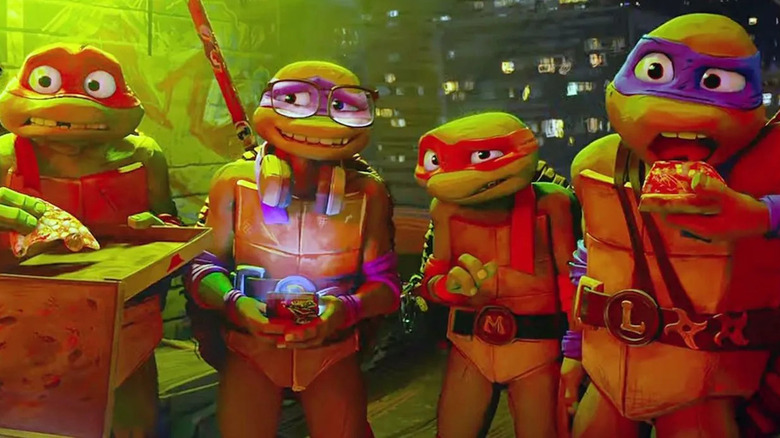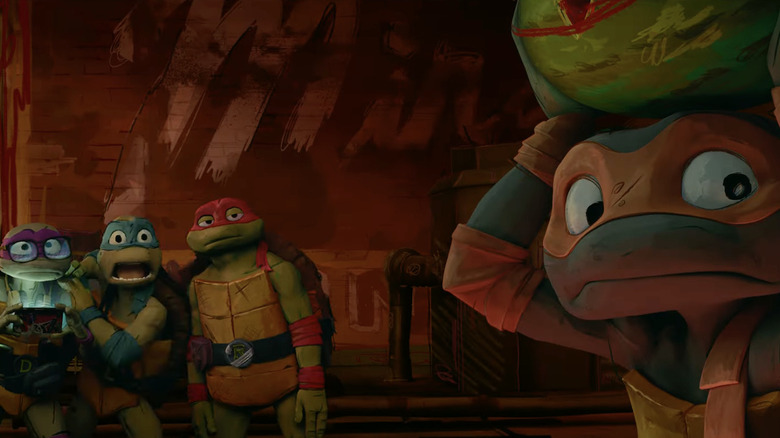Teenage Mutant Ninja Turtles: Mutant Mayhem Ending Explained: Can I Kick It?
This piece was written during the 2023 WGA and SAG-AFTRA strikes. Without the labor of the writers and actors currently on strike, the movie being reviewed here wouldn't exist. This article also contains major spoilers for "Teenage Mutant Ninja Turtles: Mutant Mayhem."
When Kevin Eastman and Peter Laird created the "Teenage Mutant Ninja Turtles" comic book in 1984, they were deliberately riffing on several comic books of the early '80s that were already quite popular. Yet their concept was so out there, it looks increasingly bizarre on paper the longer you look at it: a quartet of baby turtles becomes mutated and anthropomorphized, grow into wisecracking teenagers, get trained in martial arts by a mutant rat who raises them (and names them after famous Renaissance artists), and fight crime. How could these outrageous characters and their wacky story be easily accepted?
The answer, as it turned out, was "easily and rapidly." The Teenage Mutant Ninja Turtles have been a staple of pop culture since their inception, launching into media frenzy levels of fame with the combination of the hugely popular cartoon series that ran from 1987-1996 and its attendant line of toys and other merchandise. That series established the "Turtles" media legacy: a live-action big-screen trilogy, more cartoon shows, a jaw-droppingly bizarre rock band stage show, two live-action reboot movies, and a 2007 animated film.
That's right: the latest Turtles adventure, "Mutant Mayhem," is not the first TMNT animated movie. The characters have remained so popular over the nearly 40 years they've been around that it's hard to imagine a world without them. Yet in telling the origin of these new Turtles all over again, "Mutant Mayhem" not only makes some significant changes, but hones in on the inherent, underlying metaphor of these terrific teens: under their shells, they're just unique individuals who yearn for acceptance and hope to find where they belong, both amongst themselves and in the big, mean world.
Save Ferris
"Mutant Mayhem" opens with a flashback to 2008, where outcast scientist Baxter Stockman (voiced by Giancarlo Esposito) attempts to rescue his creation — a mutant fly — while dumping the mutagen ooze he's concocted down the literal drain as his lab is invaded by the mercenary-like goons who work for Cynthia Utrom (Maya Rudolph), head of the mysterious TCRI labs. While Stockman dies during the altercation, the fly escapes and the ooze makes its way to the sewer, where the Ninja Turtles and their guardian, Master Splinter (Jackie Chan) are "born."
15 years later in the present day, Leonardo (Nicolas Cantu), Donatello (Micah Abbey), Raphael (Brady Noon), and Michelangelo (Shamon Brown Jr.) are four average pizza-loving Zoomer teenagers — except for the fact that they're mutant turtles, know martial arts, and live in the sewer beneath Manhattan. They're also deliberately banned from interacting with humans on Splinter's orders, after a disastrous encounter Splinter had years ago when he attempted to allow the turtles to see the surface world.
However, being curious, social media-addicted teens with access to the internet, the turtles have actually been stepping out on their Master regularly, attending Adele concerts and other events in secret. After getting groceries, the foursome decides to check out an outdoor movie night that's screening 1986's "Ferris Bueller's Day Off." The wish-fulfillment teen comedy has a profound effect on the turtles, who not only envy the title character's autonomy but his rampant popularity. This causes the turtles to openly wonder how to become accepted by humans and achieve their biggest dream: attending high school.
Doing good for all the wrong reasons
That opportunity turns out to be just a ninja star's throw away, as a stray shuriken hits the helmet of human teenager April O'Neil (Ayo Edebiri) while the turtles are goofing around on a rooftop. After the turtles rescue April's scooter from a nearby chop shop, the high school student and aspiring reporter reveals she's taken it upon herself to investigate the wave of crimes occurring in NYC that have been perpetrated by the criminal known only as Superfly (Ice Cube). The turtles and April work out a mutually beneficial agreement: they'll use their ninja skills to capture Superfly and bring him to justice, which April will document for her school paper.
Although the turtles and April embark on this quest for outwardly altruistic reasons — fighting crime for the turtles, getting the city-imposed curfew, and cancellation of prom reversed for April — they actually have deeper, more selfish motivations. The turtles believe that becoming heroes will instantly allow them to be fully accepted by humans, while April hopes that bringing prom back will make her peers forget about her unfortunate on-camera anxiety that occurred when she tried to perform the morning announcements, resulting in the cruel nickname "Puke Girl."
Nevertheless, everything is going according to the turtles' plan until they actually arrange a meet with Superfly, who reveals himself to be none other than Baxter's mutant fly all grown up. He leads a motley crew of other mutant orphans, all of whom hope to live in a world that accepts them as much as the turtles and Splinter do. However, the turtles are shook when they discover that Superfly plans to use a device he's built from the tech that he's stolen that will turn every animal into a mutant and make humanity an enslaved (or doomed) race as a result.
God loves, Man milks
Superfly's plan of forced, unnatural selection isn't just highly similar to the goal of Magneto in 2000's "X-Men," but reminiscent of "X-Men" comics in general, revealing TMNT's general subtextual debt to Marvel's own mutants. Ironically, the turtles are big Marvel Cinematic Universe fans (the MCU having not quite yet introduced mutants into their films), and it's partially because of their innate sense of empathy and justice that they decide to try and stop Superfly despite empathizing with his and their fellow mutants' wishes.
Sadly, the turtles not only fail in their attempt to stop the other mutants, but they also end up getting captured by Cynthia Utrom and her TCRI squad. One of the film's great running gags is Splinter being adamant that humans will want to capture the turtles and milk them, a claim that the turtles regularly roll their eyes at. To their dismay, it turns out Splinter was more right than he knew, as Utrom hooks the turtles up to a milking machine (literally, that's what it's called) in order to obtain their mutagen-riddled blood for the purposes of manufacturing a mutant army.
Fortunately, Master Splinter gets tipped off by April as to the turtles' plight, and the ninja rat saves his sons from any further malicious milking. It's here that some of the revisions "Mutant Mayhem" makes to the Turtles' legacy fall into place. Just like Eastman and Laird blended popular comics of their day into a heady stew, "Mutant Mayhem" director Jeff Rowe allows the film's copious pop culture references to be a story point in addition to setting character and tone, going so far as to mix live-action source footage with the film's animation. Here, Splinter isn't a former human martial arts master, but a former rat who learned to perform and teach martial arts through kung-fu action movies. Thus, Splinter, the turtles, and the other mutants demonstrate a deep adoration of human culture, making it easier for them to accept that humans, despite their potential prejudices, aren't necessarily the enemy.
Super Godzilla marshmallow fly
It's this appeal that the turtles and Splinter make to the mutant gang, as they explain to Genghis Frog (Hannibal Buress), Leatherhead (Rose Byrne), Rocksteady (John Cena), Bebop (Seth Rogen), Wingnut (Natasia Demetriou), Ray Fillet (Post Malone), and Mondo Gecko (Paul Rudd) that destroying or enslaving humans would make the mutants no better than the worst of humanity. While the mutants happily agree to back down and come and live with the turtles and Splinter in the sewer, Superfly is too far gone and insists on using his device. In the ensuing fracas, the device and Superfly fall into the river, and the unleashed mutagen combines Superfly with nearby wildlife into a giant, monstrous creature: Super Duper Fly.
Again, "Mutant Mayhem" demonstrates its savvy in blending pop culture new and old: the turtles devise a plan for stopping the now kaiju-level threat of Super Duper Fly by comparing the situation to "The Avengers" and "Attack on Titan," while Super Duper Fly himself makes "Godzilla" references and the entire ethos of this third act — where four unlikely weirdos attempt to save NYC from a giant rampaging monster — recalls both 1984 and 2016's "Ghostbusters."
The turtles decide to stop Super Duper Fly despite the fact that humans may still not accept them. Everyone pitches in: the turtles and Splinter, the mutants, and most of all April. She runs into nearby Channel 6, overcomes her anxiety (mostly), and takes over a broadcast spewing fear-mongering anti-mutant rhetoric. With April telling the city what's really going on, the humans of NYC come to the mutants' aid, and Super Duper Fly is soon de-mutated thanks to some swiped TCRI tech.
Coming out of their shells
As the turtles and the other mutants are praised by the city for their heroism, Mikey, Donny, Leo, and Raph are overjoyed to discover that this praise leads to their acceptance. It's here that "Mutant Mayhem" reveals itself as not a typical superhero story. While so many comic book heroes from "Batman" to "Spider-Man" to the "X-Men" involve their heroics being begrudgingly praised while they themselves are shunned from society, here the turtles and the mutants find themselves integrated into society pretty smoothly.
To wit, the mutants are living as one big, happy family beneath the sewers while the turtles finally achieve their dream of attending high school (Eastman High, in a sweet nod to the Turtles' co-creator). Although they've been brothers since birth, the turtles all yearned to express their individuality and find their calling, a quality which first emerges as their choice of weapons and role in their crime-fighting team. In school, Raph the hot-tempered fighting man joins the wrestling team, Mikey the quick-witted improviser joins the improv team, Donny the tech and anime-obsessed dude finds his people with the like-minded, and Leo the leader teams up with the now-respected-by-her-peers April to do some investigative journalism (their first story: who or what is behind TCRI) as well as go to the now-uncancelled prom together.
It's fitting that the soundtrack to "Mutant Mayhem" features a bunch of upbeat old-school pop and hip-hop tracks, including the song "Can I Kick It?' by one of the most positive hip-hop acts of all time, A Tribe Called Quest. Rather than a dark and gritty comic book adaptation featuring horrific mutations, ninja cults, and gratuitous villainy, "Mutant Mayhem" sees a bunch of misfits just looking for love and acceptance.
Return to Shredder, address unknown
Of course, there's no doubt that Rowe and producers Rogen, Evan Goldberg, and James Weaver hope that "Mutant Mayhem" kicks off a new cinematic franchise. As such, in the movie's post-credit scene, it's revealed that Cynthia Utrom is keeping a close eye on the turtles from afar. While Cynthia herself is a brand new character to the TMNT lore, her last name as well as her appearance seems to announce her true identity: she is most likely an Utrom, one of the evil alien beings who have traditionally been represented by the blob-like talking brain Krang. As such, Cynthia's wardrobe is highly reminiscent of what Krang's android body wore on the old TV series.
Of course, Krang (or another Utrom, as Cynthia seems to be) isn't the only classic villain to be teed up: as Cynthia ominously ponders how to capture the turtles once and for all, she commands: "Bring me ... the Shredder." Sure enough, the last shot of the film is of the Shredder's imposing silhouette as he stares at the NYC skyline, ready to strike.
Although these hints seem to point to another classic bout between the Ninja Turtles and Shredder, if "Mutant Mayhem" teaches us anything, it's that almost all bets are off for the adventures of these turtles. The film uses "Can I Kick It?" as a sly dual message: it's both a plea for acceptance as well as a possible threat, coming as it does from ninja-trained turtles. Utrom, Shredder, and other haters had better keep that in mind.
